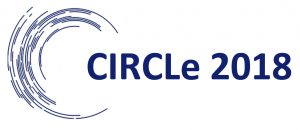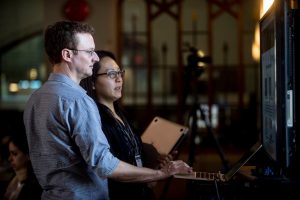Networking ePortfolios: Integrating Technology with Learning and Connecting to the Real World, 1:30 pm to 2:45 pm
- How can educators encourage students to make connections between their academic work and life experiences?
- How might we better integrate e-portfolios in courses to improve student engagement?
- What kinds of projects get students to use the technology effectively, both during and after the course?
- What are the shared overlaps and differences between learning portfolios and career portfolios?
TABLE 1 DISCUSSION:
- Role of reflection: How much reflection is necessary?
Being able to reflect and showcase, that is important part of learning experience b/c can then understand what you took out of an experience, what you learned.- But does it go too far sometimes? How much reflection is necessary?
- Showcase your reflection so you know what skills you got from the course – recognize the problem, impact, and what to do next. Don’t want to spend too much time talking about what you did wrong; provide reflection as needed to provide context for talking about impact of what you did—focus also on the end result not just the process.
- Can go too far in cathartic aspects of reflection.
- Give guidelines to students so they do the necessary reflection but don’t get lost in the inquiry process.
- Build an inventory of reflection questions for students based on their disciplines and scaffold their reflection and ePortfolio process over their years at UBC
- Including something that went wrong is fine but focus also on what you learned from that, what are your plans for the future based on that. Showcase ability to problem solve.
- Don’t just show your shiny successes—that could just be your social media sites
- Show that you take risks sometimes and that it may not work out but you can learn from that.
- Scaffolding is important
- Start with small assignments & reflections, then include questions that help students think about deeper analysis of their learning, connections to other parts of their academic and non-academic lives, and coordinating the different parts of the portfolio together…all in small steps.
- Maybe don’t even call it a portfolio in first and second years because this can get them sidetracked
- But does it go too far sometimes? How much reflection is necessary?
- This is an online academic identity; before this they may just have social online identity
- Though the learning that can be showcased in the portfolio isn’t just academic; it’s useful to consider learning that happens outside of the university too, and how that links to academic learning
- Sharing culture: “If it wasn’t shared, it didn’t happen”—trying to encourage a culture of sharing at an organization/business. Talk about that rather than putting things into an official portfolio. There must also be some reward to the sharing.
- If people have to do their work and then also the portfolio on top of that w/o some kind of reward, that will feel too onerous.
- How might we create an incentive for faculty, staff and students to engage with sharing through eportfolios?
- Show people the benefits that are accruing from their portfolios and then others will want to do that too. E.g., like social media, who is getting “likes” on their portfolios?
- Portfolios as a 2-in-1 package: integrate Co-op with eportfolios so that eportfolios isn’t just another add-on.
- Multiple life paths: Don’t think you have to just focus on one life path, that everything has to be focused on that one dream job. There will be jobs you’re not even aware of that require multiple kinds of skills. Or you may change tracks over time. So it’s okay to include multiple types of things in your portfolio, multiple things you can do.
- Well roundedness gives you back-ups in your life and ePortfolios can be used to track your life trajectory and prove your community connections
- This could help convince students to engage with portfolios.
- Value of peer feedback on portfolios: students no longer just speaking to a wall or to the instructor, but it changes the audience and students can get more engaged that way.
TABLE 2 DISCUSSION:
For Christine D’Onofrio’s use of eportfolios:
This discussion was moderated by Christine D’Onofrio, which allowed an opportunity to expand on some of the presentation content.
- Students really like the look of Wix.com (versus UBC platform) but when using a template, students were dependent on the design of the template. The templates became restrictive for students, or encouraged a superficial approach. Is this partly because they were Media Studies students?
- Maybe because they were visual design students, they were more aware of how they wanted their eportfolios to look like but were not deconstructing the limitations of the template or what the template was conveying for them by these pre-loaded options?
- Wanting students to really think about the purpose of their site. Academic art is about deconstructing meaning and process. What does a Wix template say?
- New tweaks for Christine’s course:
- Students need to use WordPress instead of Wix.com
- Encouraged students to develop research questions for all of their courses that would be reflected in the ePortfolio
- Evaluation is less about what it looks like but more focused on artifact critique
- Evaluating process and reasoning why decisions were made
For David Gaertner’s incorporation of eportfolios:
- Used Omeka
- Working with a community to reflect a community project
- Did a critical analysis on websites and then completed a reflection
Other comments:
- Students are frustrated they can’t make WordPress look the way they want, and it’s too difficult to support
- Q: Can paper templating help them be more thoughtful in the transition to a digital format?
- Takes time for students to learn skills necessary to create an eportfolio.
- Encourage them to settle on a first theme within the first couple of weeks, but let them know they don’t have to be married to it — at Royal Roads they may have more support
- Set time limits for students to spend on assignments as some students get obsessed with things like rollovers which takes time away for more valuable reflection and learning.
- “Ask 3 then me (including Google)” – Idea of asking three other peers (including Google) to find the answer before approaching instructor than instructional support
- Hoping that students learn and receive feedback from each other
TABLE 3 DISCUSSION:
Certain schools/disciplines lend themselves better to e-portfolios
Q: How do you create a portfolio culture?
- through incentivizing
- faculty need to model their own
Q: How do we make faculty more open to portfolio use?
- often they are not open to students’ creativity when they just want to make the different parts of the blog/portfolio
- It’s useful to hear from people like Tommy Lewis – it’s important for students to know what employers are looking for
- Arts program as developed some videos for students with feedback from employees
Q: What is the difference between a learning and a showcase portfolio?
- guiding students to make that shift
- Fred Cutler’s project – students use WordPress as a learning tool but then allows them to select certain pieces of work to upload to a showcase portfolio with a customized url
- In the health care sector e-portfolios are a way of teaching medical professionals how to showcase what they do, without talking about their patients (which some do)
Students want to know how what they are learning relates to the real world.
The portfolio gives you more control during the interview, because it’s there and gives you something to talk about.
TABLE 4 DISCUSSION:
- At Capilano University, able to integrate ePortfolios across core courses because there’s a steering committee — easier because it was new
- Funding for peer mentors was from VP academics, now moved to CTE; 1 faculty member is lead with a course release (probably more sustainable than just X$ for cloud software)
- (new) Vantage vs in the (established) Geog Dept: Geog has 3/27 faculty involved which was useful
- Can’t dictate that everything has to be for every student → mandatory
- One other colleague is helpful for sustainability
- By third year may be too late to start
- It might be the B and C students who need ePortfolios the most, moreso than the A students
- If students get tripped up on the tech piece, miss out on the big picture
- ePortfolios used in Italian, 3rd year, to collect a set of resume, job search, etc in Italian
- https://web.hypothes.is/ including peer assessment using hypothes.is
- Instructor annotates readings, students comment on her annotations, then they come to class having engaged in dialogue already
- Nice example from GEOG: If already use service learning, use portfolio to capture experience reflections, include awareness of audience that includes the community partner (who we want to work with again!)
A potential process for a unit:
-
- We don’t want to mandate this for students or for faculty, but if enough faculty in a department are experimenting with non-traditional assignments, you could all sit down one day together, what are we all doing, and what lends itself to display in a portfolio? Then decide whether it would make sense to sync up in a portfolio, and how to do that.

